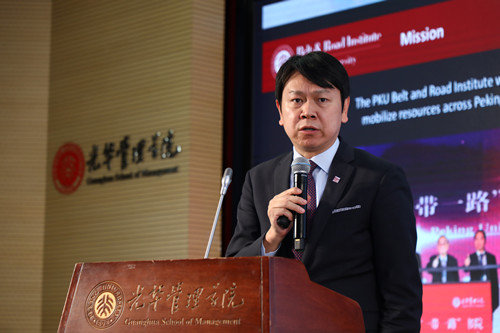Peking University, Oct. 23, 2018: On October 17, 2018, Peking University’s Belt & Road Institute hosted the opening lecture of its new “Understanding China and the Belt and Road” lecture series. With the Belt & Road initiative occupying an important place in both national and international discourse, this academic lecture series seeks to help explore opportunities and challenges surrounding the Belt & Road initiative. However, the seven-lecture series to be held over the course of the 2018-19 will take a broad view of China’s development and also explore other China-focused economic issues.
To provide analysis of the micro-level underpinnings of China’s economic development, the Institute tapped Guanghua School of Management Dean and Professor of Finance Liu Qiao to give the opening lecture entitled “Corporate China 2.0: The Great Shakeup”. The lecture attracted nearly 200 attendees representing 19 different countries, including all levels of students from universities across Beijing as well as embassy and other organization representatives.

Liu Qiao
Professor Liu suggested that the “Case of China” or “China’s Experience” can help create new approaches to global problems and shared his hope that Peking University’s Belt & Road Institute should help create academic knowledge that other countries can reference over the course of their own development.
Moving into the core of his presentation, Professor Liu focused on Chinese companies as forming the micro-level foundation of the Chinese economy and the need for companies to shift their focus away from pursuing operational scope at the expense of quality growth.
The main premise and content of Professor Liu’s presentation is below:
Professor Liu first looked back on the high levels of growth and expansion seen by China’s economy since the Reform and Opening Up period 40 years ago, reflecting on the challenges overcome during the course of the country’s economic development. He then indicated that China has entered a new phase, and as it has started to pursue quality development, some of the economy’s structural problems have come to bare. In order to solve these structural problems, it’s necessary to look at the micro-level foundations of the economy—Chinese companies.
The rapid growth of China’s economy over the past 40 years can be attributed to the rise of Chinese companies, but this process has not yielded any truly great enterprises. Chinese companies are growing larger and larger in size, but the value they are creating is not increasing along with their size. On the Fortune 500 list published in 2016, 103 Chinese companies were represented. However, the Chinese companies on the list are mostly State-Owned Enterprises that provide factors of production like capital, energy, and raw materials. In a macro-environment that relies on investment for growth, increasing operational scope is more advantageous to companies than pursuing value creation.
Professor Liu suggested that Chinese companies have continued to grow, but their Return on Invested Capital (ROIC) is relatively low. ROIC serves as an important metric for evaluating a company’s fundamentals and is important for determining the extent of a company’s competitiveness in its industry. From the perspective of ROIC, the micro-level foundations of Chinese economy are relatively week, and the performance of China’s listed companies is underwhelming.
According to the data, the ROIC for companies listed on China’s A-share market averaged a mere 3% between 1998 and 2015. In other words, every 1RMB that was invested only produced .03RMB of after-tax profit. Using the same methodology to calculate ROIC for American companies over the past 38 years, we see an average of 11.6%, which sits in very stark contrast to the situation in China.
When ROIC in Chinese companies has been relatively low, China’s conventional approach has been to rely on high rates of investment in order to achieve economic growth targets. In the past, GDP has been driven primarily through investment in real estate and construction, and many of these projects have low ROIC. Investment has also been fueled by the availability of credit from banks, leading to inefficiently-allocated resources. The large accumulation of capital is very likely to turn into systemic financial risk.
Changing the logic behind China’s growth requires a shift in focus, moving away from such heavy emphasis on investment rates and toward higher levels of capital efficiency, we need “brilliant” companies and need a different micro-level foundation. For China to transition from high-speed development to high-quality development, increasing total factor productivity and improving firm-level ROIC will need to be the primary source for future growth. This will require us to change the paradigms we have developed over the past 40 years.

Reforming the foundations of the economy leaves the vast majority of Chinese companies grappling with the question of how to make value creation and investment efficiency a higher priority than operational scope. Entrepreneurial spirit and innovation are among the most important ways to make this transition successful. Professor Liu indicated that innovation can be broken down into four types: customer-focused innovation, efficiency-driven innovation, science-based innovation, and technology-based innovation. China excels in the first two types of innovations, but going forward, it must work to improve its science-based and technology-based innovations by increasing R&D investments.
Current R&D investment in China sits at about 2% of GDP, which is on par with average levels of R&D investment in the European Union. However, in comparison with the United States, Japan, France, Germany, and other countries, levels of R&D investment are relatively low. Levels of R&D in Israel and South Korea, for example, have reached more than 4% of GDP. Furthermore, China has not made sufficient investment in original basic research, meaning that we can only be users of advanced technology and have not reached the stage where we can be true leaders in the development of core technologies. Entrepreneurial spirit with Chinese characteristics has enabled the countries rapid growth and laid the foundation for high quality growth, and this entrepreneurial spirit will also play an important role in achieving a successful transition.
Background info:
Peking University Belt & Road Institute Lecture Series: Understanding China and the Belt & Road
Peking University announced its new Belt and Road Institute on April 20, 2018. The Institute, rooted in Guanghua School of Management, will provide educational opportunities to future leaders for the new type of globalization, conduct research relevant to BRI projects, and serve as a platform for people-to-people exchange. Over the 2018-19 academic year, the Belt & Road Institute will be organizing a series of lectures entitled “Understanding China and the Belt & Road” for local and international scholars alike. The lectures will serve as a platform for high-level analysis and critique from leading Chinese academics, industry professionals and commentators on what lies ahead for businesses as the global environment changes and boundaries shift.
Edited by: Zhang Jiang
Source: Guanghua School of Management

